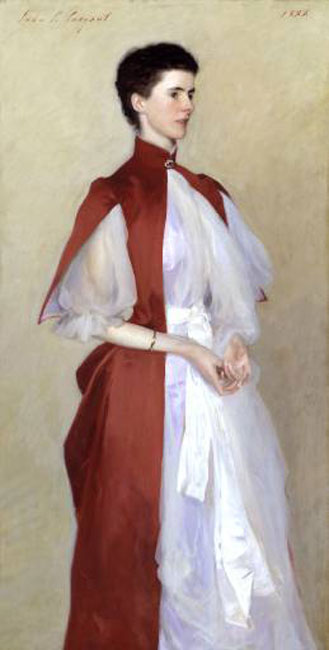|
Portrait of Mrs. Robert
Harrison
(née Helen Smith)
John Singer
Sargent
-- American painter
1886
Tate Gallery, London
Oil on canvas
157.8 x 80.3 cm
Bequeathed by Miss P.J.M. Harrison
2000;
T07693
Jpg Tate
Gallery
From: Tate Gallery
Heather Birchall; December 2001
. . . [Sargent] may have been
introduced to the cousins Robert and Peter Harrison by Alma Strettell.
The future wife of Peter Harrison, Strettel was a close friend of
Sargent and, in 1877, he had illustrated her book, Spanish and Italian Folk Songs.
Mrs Robert Harrison, née Helen Smith (c.1858-1936), was the daughter of
a wealthy Tyneside businessman and politician. At the age of nineteen
she married the stockbroker and musical connoisseur, Robert Harrison of
Shiplake Court, Henley. The Harrisons, like many of Sargent's patrons,
formed part of the high society of late Victorian Britain. However they
had unconventional tastes. For example in 1886, the year of this
portrait, Robert Harrison also bought one of Whistler's night time
views of London, Nocturne
in Blue and Gold: Old Battersea Bridge (Tate N01959). At this
time memories of the notorious libel case between Ruskin and Whistler
which had taken place in 1878 were still alive in the public
imagination (Ormond, p.144).
The Portrait of Mrs. Robert Harrison
was begun in 1886, shortly after Sargent had returned from a summer in
France. Ormond has suggested that this painting is a bridge between the
two dominant styles of late nineteenth-century French painting, Realism
and Impressionism. The details of the head and hands are precise, yet
the colouring of the portrait shows a move away from the old masterly
emphasis of Sargent's style, inspired by his friendship with Monet and
the work of the Impressionist artists he had seen in France.
The change in Sargent's style
contributed eventually to the creation of a market for his portraits
among members of London society, but approval came slowly. Following
the exhibition of this portrait at the Royal Academy in 1886, The
Athenaeum reported that 'An exercise in white, red and grey; is,
so far as this goes, excellent, although it is decidedly unpleasant as
a household companion, and, for the owner's sake, we hope unjust to the
lady' (Ormond, p.144). Her unusual dress was also commented upon. The
columnist for the Evesham Journal and Four Shires Advertiser exclaimed
that she had never seen Mrs. Harrison 'wearing such red wing-like
appendages to her costume, which look as though about to expand and
convey her to the regions of Mephistopheles' (Ormond, p.144). Two years
after this portrait was completed, Sargent painted the Harrison's
eldest son, Cecil (Southampton City Art Gallery). In contrast to the
portrait of Mrs. Robert Harrison, Sargent's portrait of the ten year
old Cecil was praised by the Art Journal for 'the brilliance
and purity of its flesh colour and for the truth with which the boy's
navy-blue costume has been represented.' (Ormond, p.183)
(Tate
Gallery London)
Notes:
Bibliography:
William
Howe Downes, John S. Sargent: His Life and Work, Boston 1925,
p.143
Richard Ormond, Elaine Kilmurray, John Singer Sargent : Complete
Paintings Volume 1: The Early Portraits, New Haven and
London 1998, pp.18 and 144-5, reproduced in colour p.145
|





